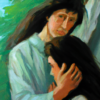Active love is a powerful tool that can help us to overcome emotional obstacles and build stronger relationships. It is about making a conscious effort to reach out to others, even when we don’t feel like it, and being open to receiving love in return. In the novel “The Brothers Karamazov,” the character of Alyosha serves as a powerful example of active love in action.
Phil Stutz and Barry Michels, in their book “The Tools: Transform Your Problems into Courage, Confidence, and Creativity,” describe active love as a way to break through isolation and reconnect with others. They argue that when we are experiencing emotional pain or difficulties, it is easy to withdraw and become isolated. Active love is a way to break through this isolation and reconnect with others. Similarly, Erich Fromm in his book “The Art of Loving” also describes love as a skill that can be learned and developed, and it is essential to human well-being.
In “The Brothers Karamazov,” we see Alyosha embodying this concept of active love. Despite the pain and suffering caused by his family, he actively chooses to love and care for his brothers, Dmitri and Ivan. He reaches out to them, offers support and understanding, even when they are at odds with each other. He also tries to mediate between them, to help them reconcile and heal their relationship.
Alyosha also demonstrates active love in his relationship with Lise, a young girl who is suffering from a terminal illness. Rather than see her as a sick and dying child, he chooses to see her as a person with feelings and needs. He actively listens to her, offers her words of encouragement, and helps her to find meaning and purpose in her life. He also comforts her and gives her hope, despite her condition.
Furthermore, Alyosha’s active love is shown in his actions as a monk and spiritual guide. He offers spiritual guidance and support to the sick and suffering members of his community. He visits the prisoners in the local jail, he helps the poor and the needy, and he offers comfort and solace to those who are going through difficult times.
One of the most striking examples of active love in “The Brothers Karamazov” is Alyosha’s relationship with Ivan. Ivan is struggling with his own inner turmoil, and Alyosha actively chooses to reach out to him, to understand him, and to offer him support and guidance. Ivan is skeptical of love, and he expresses his views about the cruelty of the world, the suffering of children, and the problem of evil. Despite this, Alyosha does not give up on him, and he continues to reach out to him with active love. He listens to Ivan’s doubts and struggles, and he tries to help him find meaning and purpose in his life. He reminds Ivan of the power of love, and how it can overcome the darkness and despair.
Eckhart Tolle in his book “The Power of Now” also describes the power of being present in the moment and how it can lead to a more fulfilled and loving life. Tolle argues that living in the present moment can help us to connect with others and the world around us in a more meaningful way. This is something that Alyosha embodies as well. He chooses to be present in the moment, to be attentive to the needs of others, and to offer them a listening ear and a loving heart.
In a world where many people talk about love but few people act on it, Alyosha serves as a powerful example of active love in action. His actions show us that love is not just a feeling, but it is also a choice. It is something that we can actively choose to do, even when we don’t feel like it. By following Alyosha’s example, we can learn to break through our own isolation and reconnect with others. We can learn to offer love and support to those who need it, and in turn, we can learn to receive love and support in return.
In addition to the authors already mentioned, Tara Brach, a renowned psychologist and author of “Radical Acceptance” and “True Refuge,” also emphasizes the importance of active love in her teachings. Brach emphasizes the idea of radical self-compassion, which involves actively choosing to love and accept ourselves, even in difficult moments. She encourages us to move beyond self-judgment and criticism and to actively cultivate a sense of love and compassion towards ourselves.
When we actively choose to love ourselves, we create a foundation for loving others. Brach states that, “Loving ourselves is not self-indulgence, it is self-preservation.” By actively choosing to love ourselves, we can break through the cycle of self-criticism and negative thoughts, and instead, we can focus on actively loving and caring for ourselves and others. In conclusion, active love is a powerful tool that can help us to overcome emotional obstacles and build stronger relationships. “The Brothers Karamazov” by Fyodor Dostoevsky, serves as a powerful example of active love in action and it teaches us the importance of actively choosing to love and connect with others, even in the face of hardship and suffering. By following the examples of Alyosha Karamazov, Phil Stutz and Barry Michels, Tara Brach, Erich Fromm and Eckhart Tolle, we can learn to break through our own isolation, and build stronger and more meaningful relationships with others.
